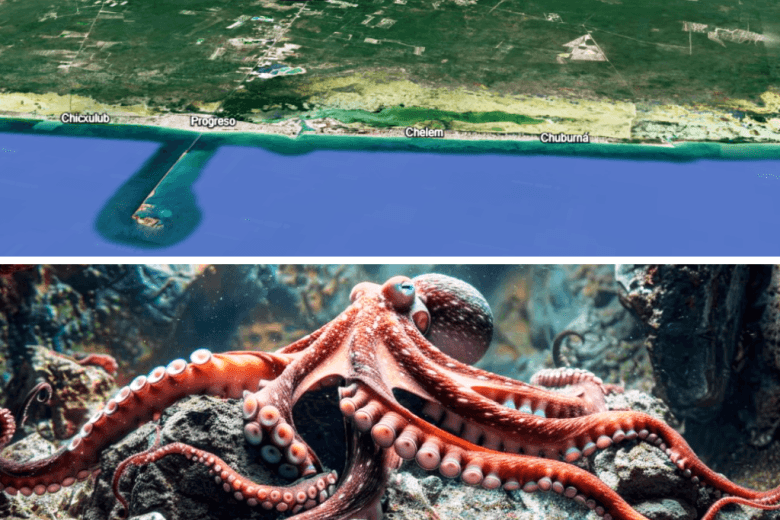Mérida, Mexico — The government of Mexico has established a new fishing sanctuary for flora and fauna in Yucatán, named El Cerrito, intended for the repopulation of five species of commercial value and others. The measure is expected to benefit 450 fishers through increased catches starting in the year 2030.
El Cerrito is the sixth fishing sanctuary established in Yucatán since 2019, the fourth in 2025, and the second one established in September of this year. Previous sanctuaries were established in Celestún in 2019; Dzilam de Bravo-San Felipe in 2024; and El Cuyo, Chabihau (both in February), Telchac Puerto, and now El Cerrito (both in September 2025).
El Cerrito Designated as a Temporary Partial Fishing Refuge
According to an agreement published by the Secretary of Agriculture and Rural Development (Sader) on September 26, 2025, in the Diario Oficial de la Federación, El Cerrito will be a Temporary Partial Fishing Refuge Zone for a period of five years.
The sanctuary encompasses 49.48 square kilometers (4,948 hectares) of federal waters adjacent to Chuburná Puerto, Progreso, Yucatán. Sader describes the area as having a hard bottom with a superficial sand layer, some sections of flat rock and isolated coral promontories, and a constant presence of red, green, and brown algae with a sparse quantity of sponges.
Permitted and Prohibited Activities in the Sanctuary
In accordance with Official Mexican Standard NOM-049-SAG/PESC-2014, Sader specified that within El Cerrito, only "commercial fishing of octopus (Octopus maya) using the traditional 'garateo' fishing gear (an artisanal fishing method) is permitted, while respecting the current closed season." The closed season for octopus runs from August 1 to December 15 of each year.
The agency added that in El Cerrito, "sport and recreational fishing, as well as domestic consumption fishing of any species of flora and fauna, is strictly prohibited."
A Sanctuary Born from a Local Request
Sader noted that the 450 fishers who operate 139 small vessels in Chuburná, Progreso, are grouped into five cooperative societies and 31 permit holders that form the Chuburná Nautical Committee.
In a written request submitted to Mexico's National Aquaculture and Fishing Commission (Conapesca), the Chuburná Nautical Committee asked for El Cerrito to be designated as a Fishing Refuge Zone for five years.
In their submission, the fishers of Chuburná reported that coastal fishing is their primary source of income, but they have observed an increase in the overexploitation of fishing resources in the region and a decrease in the volume of catches of the most important commercial species.
A 71 Percent Plunge in Octopus Catch Over Five Years
The fishers provided specific data on declining catches: the fishing of red octopus (Octopus maya) plummeted by 71 percent between 2018 and 2022, and the catch of red grouper (Epinephelus morio) fell by 50 percent between 2012 and 2022.
Consequently, they requested the Temporary Partial Fishing Refuge status for El Cerrito as a fisheries management measure, with two primary objectives:
- To protect critical areas for the reproduction, spawning, and rearing of marine species important to the community's fishery, specifically the red octopus (Octopus maya), red grouper (Epinephelus morio), black grouper (Mycteroperca bonaci), the Caribbean spiny lobster (Panulirus argus), and the sea cucumber (Isostichopus badionotus).
- To improve fishing productivity by encouraging the recovery of the population biomass in El Cerrito and adjacent areas through a spillover effect, thereby contributing to the restoration of fishing activity in the region.
Five-Year Term Deemed Minimum for Measurable Effect
Sader ultimately accepted the proposal and restricted nearly all fishing in El Cerrito for five years. The agency explained that this period is "the minimum time in which the growth effect on the populations of red and black grouper, spiny lobster, and octopus, among other species that inhabit the area, can be observed, measured, and evaluated, given the expected level of dispersion of the biomass of said populations."
Authorities Warn of Sanctions for Violators
Finally, Sader warned that individuals who violate the agreement will be subject to the penalties established in Article 133 of the General Law for Sustainable Fishing and Aquaculture.
This law stipulates seven types of sanctions: a formal warning, a fine, an additional fine for repeat offenses, arrest for up to 36 hours, closure of facilities, confiscation of vessels, fishing gear, vehicles, and any illegal catch, and the suspension or revocation of fishing permits or concessions.
Discover more from Riviera Maya News & Events
Subscribe to get the latest posts sent to your email.
